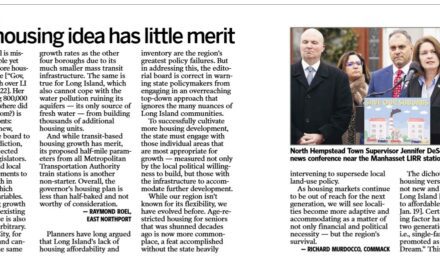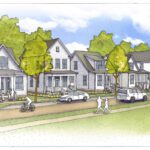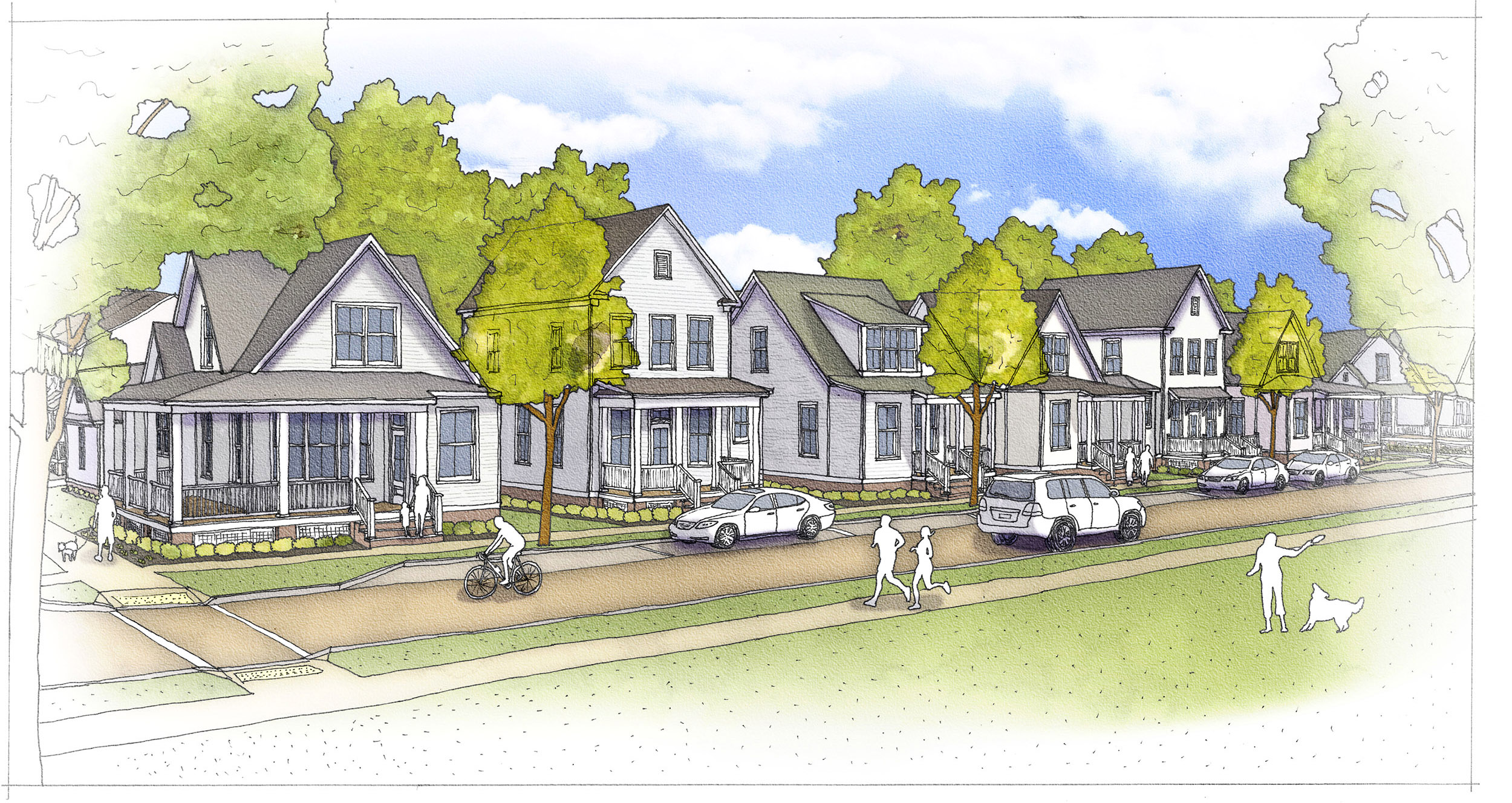The following was published in the September 2017 edition of Long Island Pulse Magazine. You can read Pulse’s edited version here.
The rise of mixed-use residential housing projects has surged in an effort to attract a new generation of transit-oriented commuters in recent years. But the single-family home is a stalwart piece of the region’s landscape. Demand remains strong—although many communities are embracing apartment developments, others eschew the idea of rezoning existing neighborhoods to contain such dense construction.
Residents still aspire for the tidy layout Levitt laid down in a potato field in the 1940s. At public hearings discussing new development proposals, residents can often be heard lamenting that they left the City in order to avoid such development. “I left Queens for the more peaceful and open landscape of Long Island,” Nassau Country resident Gina Lutter wrote on a petition to block a development complex. Lutter proceeded to say that the project would create what she called a “mini-Queens” along the area’s waterfront.
For some communities however, changing their pre-existing housing stock isn’t an option, but an economic necessity. Across Long Island, downtowns that have struggled in years past near active LIRR stations have found varying degrees of success with building apartments and multifamily projects, especially when these efforts are paired with nurturing a friendly environment for local businesses.
In more traditional residential neighborhoods, the single-family home is the dominant option by choice. Homeowners in these areas have invested heavily in their community, and in turn expect the suburban quality of life that brought them to the area in the first place. To many, Long Island’s identity is rooted in these neighborhoods, and residents are wary of anything that challenges it.
Developers often take a different view, arguing that the Nassau/Suffolk region represents a Pollyanna-esque past that Long Islanders should no longer embrace. “Mayors and village boards have to allow for greater density,” Nicholas Terzulli, director of business development for the Nassau County Industrial Development Agency said at a recent real estate industry event. Terzulli went on to stress the importance of soliciting buy-in from the local community, advocating for an alternative to the top-down approach so many residents perceive.
Developers note the future is progressing toward higher residential density, delivered in the form of multifamily living. “Building quality developments, that’s the solution,” Scott Burman of the Engel Burman Group said during the same forum. But the reality is that if a project doesn’t get support at the grassroots level, it can be an uphill battle to secure approvals, if it all. Some builders seek the path of least resistance and build to match local expectations.
Shawn Elliot, president of Woodbury-based Shawn Elliott Luxury Homes & Estates, worked with Hicksville-based Continental Pinewood Development Partners to develop 23 luxury homes on a 40-acre property in Dix Hills that once housed the Dix Hills Country Club. Elliot told Pulse that he never considered building anything but single-family units on the property. “They would have never allowed it. Multifamily would never happen in Dix Hills.” In this case, the developer chose to build within the as-of-right zoning of one unit per acre and faced little to no opposition as a result.
There is marked demand in the single-family market, especially for new construction, Elliot said. “Everybody wants new. The young customer today has a different definition of luxury. They don’t want the ornate touches of the Ritz—they want modern,” he said, adding that people in their late 30s and early 40s are simultaneously growing their families and businesses. “They’re basically growing out of their houses. As a result, they need bigger houses and the homes they have are becoming dated. The option is to either update their existing home or buy new. It’s easier to buy new.”
Yet construction of new single-family housing is relatively stagnant, despite the demand. In June, Nassau County saw a 6.7 percent increase in median sales price compared to last year, according to data released by Multiple Listing Service of Long Island. The increase was mostly driven by high demand and low supply. In Suffolk, the same metric experienced a year-to-year drop of 1.4 percent. Overall, there was a 17 percent decrease in listings across the region.
Mixed-use builders are quick to point out the downsides to this traditional suburbia. “Single-family costs a lot on the infrastructure side,” said Sean McLean, vice president of planning and development for Plainview-based Renaissance Downtowns. “It takes a lot of resources to keep them running. And their future value as an investment is questionable. There are just so many large houses for sale on Long Island below their replacement value.”
Renaissance Downtowns is known for their efforts to build large-scale, mixed-use efforts in areas such as Huntington Station and Riverside, and has encouraged local governments and communities on Long Island to pursue a denser residential model. “Multifamily is much more socially and environmentally responsible,” McLean continued, citing that mixed-use projects require less supportive infrastructure and place less of a burden on community services. “With multifamily, projects require far less sewer pipe, roads and space for the amount of people living in those developments compared to the same amount in single-family homes.”
On the political end, policymakers are pushing to balance approaches by re-examining each housing type. The Rauch Foundation’s Long Island Index issued a June 2017 report that explored the policy environment of accessory apartments—a true blending of the single-family and mixed-use approaches. “The single-family neighborhoods that defined Long Island’s appeal are now home to shrinking families struggling to cover the costs of all those empty bedrooms,” the report concluded.
The Index’s research found that these apartments can help alleviate the high costs of living, as well as the lack of diversity in housing stock. “Permitted apartments are widely considered to have proven their worth as the most affordable, safe and legal type of housing in the region, one that blends well into single-family neighborhoods, generates few complaints and is increasingly well accepted by residents,” report author Elizabeth Moore wrote.
The type of housing isn’t as important as whether or not it is affordable, the Index reported. “Affordability is key to the region’s economic future,” said Ann Golob, director of the Long Island Index, in a statement released concurrently with the report. “Accessory apartments are not the only solution, but this study shows that they are a necessary one.”
With market demand for single-family housing still going strong, accessory dwellings seem to be a missing, yet critical piece of the housing puzzle. “Accessory units should be encouraged,” McLean said. “They can help preserve the generational integrity of a family, and allow for additional housing options. To us, they’re always a benefit.”
Despite his company’s preference toward multifamily, McLean admits there is a place for single-family on Long Island. “It’s just a different lifestyle in single-family suburbia. The value of the single-family product is that it ensures people stay in an area for extended periods of time.”
Richard Murdocco regularly writes and speaks on Long Island’s real estate development issues. He is the founder and publisher of The Foggiest Idea, an award-winning public resource for land use in the New York metro region. More of his views can be found on www.TheFoggiestIdea.org or follow him on Twitter @TheFoggiestIdea. You can email Murdocco at Rich@TheFoggiestIdea.org.










I remember the startup of Levitttown and the once beautiful farmlands it replaced!
Many veterans found their dream locations there. As their families grew in size, some placed additions onto the original structures, and new cities appeared.
In today’s world, the tendency is to build up, rather than sideways. Of course, this primarily is due to to the small lot sizes! The Levitt Family would not be able to recognize its original plans!
Road construction could not keep up with the traffic issues that resulted…..to this day, sprawl remains an issue!